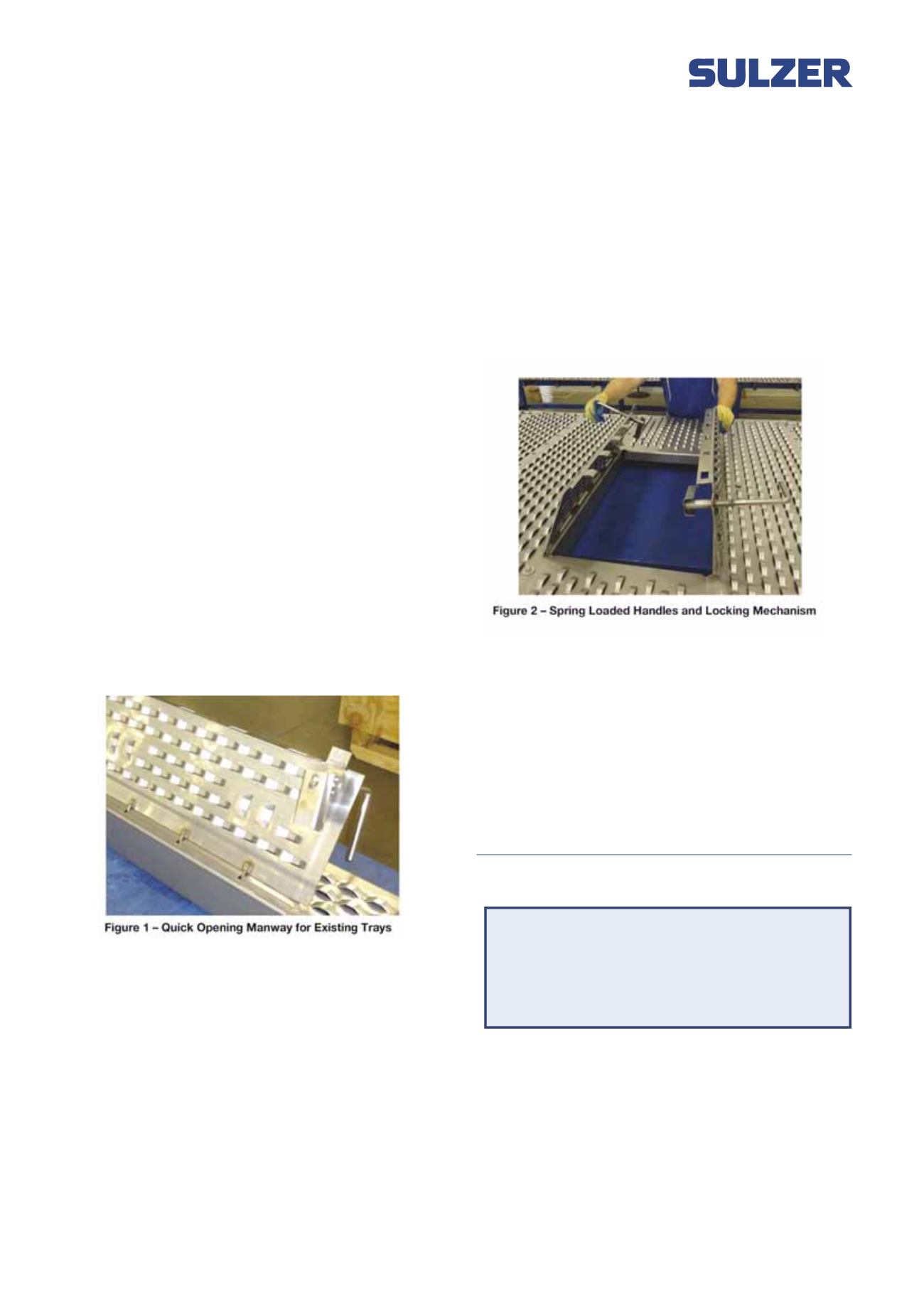
Legal Notice:
The information contained in this publication is believed to be accurate and reliable, but is not to be construed as implying any warranty or guarantee
of performance. Sulzer Chemtech waives any liability and indemnity for effects resulting from its application.
Tower Technical Bulletin
Reduce Column Maintenance Time with Quick Opening Manways
Background
The quick opening manway was first designed in 1978
(1)
. Ever
since there have been numerous variations to the original design
to facilitate a faster way to traverse quickly through a trayed
distillation tower. Sulzer Chemtech has also improved upon
the original concept and currently has two varieties of Quick
Opening Manways (QOM) to help reduce tower maintenance
time and cost.
Quick Opening Manway Features
Traditional tray manways will have about 20 bolted assemblies
that attach one manway securely to the tray deck. It takes this
number of assemblies because the flat sheet metal manways
frequently get dislodged during operation. To secure each of
these manway assemblies (or remove them), it takes between
30 to 60 seconds. This means that each manway takes 10 to
20 minutes to be closed (or opened). A tower with 20 trays, for
example, will take between 3 to 6 hours to close the manways.
Therefore, it is advantageous that a QOM must be able to be
opened (or closed) in seconds and it must be also be as strong
and secure as a normal manway.
Manway Type #1 – For existing trays
Existing manway hardware designed and supplied originally
by Nutter Engineering and Sulzer Chemtech used the “slide
fastener” design. These assemblies used slots in the tray
decks to enable the bolt assembles to slide onto the manway
and secure it to the tray deck. Sulzer’s new Quick Opening
Manways are designed so that their outer extended tabs
(2)
fit
directly into the existing slots of the previous conventional
manways (see Figure 1).
Manway Type #2 – For New Trays
For new applications the securement at the manway edge is
accomplished with Sulzer’s Lip Slot design
(3)
. Lip Slots have
been employed in the distillation tray industry since 1965.
Quick Opening Manway Strength
Both QOM types use spring loaded handles to secure the
manway to the tray deck and reduce the installation (and
removal) time of the manway to seconds. In addition, they both
utilize the Split Manway locking mechanism that enhances the
physical strength of the manway itself. The locking mechanism
makes the center of the manway a structural member ensuring
that the QOM is much stronger than a traditional manway. This
enables the QOM to be secured simply with 2 Spring Loaded
Handles at each end of the Manway.
Important Message
Quick Opening Manways are best suited for those applications
where the trays periodically foul and the trays need to be
opened for cleaning 2 or 3 times annually. This is especially
true for Beer Towers in the Fuel Ethanol industry. One
unexpected shutdown for cleaning of a Beer Tower will pay for
a set of QOMs.
See the cited references for additional information;
(1) McClain, R.W. US Patent 4120919, Filed 23 May, 1977
(2) Patent Pending
(3) Sulzer TTB
3 Cost Effective Ways to Strengthen Trays
against Uplift
www.sulzer.comPlease check for your local contact
The Sulzer Applications Group
Sulzer has over 150 years of in-house operating
and design experience in process applications. We
understand your process and your economic drivers.
Sulzer has the know-how and the technology to design
internals with reliable, high performance.
North and South America
Sulzer Chemtech USA, Inc.
8505 E. North Belt Drive
Humble, TX 77396, USA
Phone:
+1 281 604-4100
ctus@sulzer.comEurope, Middle East and India
Sulzer Chemtech Ltd.
P.O. Box 65
8404 Winterthur, Switzerland
Phone:
+41 52 262 50 28
chemtech@sulzer.comAsia Pacific
Sulzer Chemtech Co., Ltd.
10 Benoi Sector
Singapore 629845
Phone: +65 6515 5500
ctsg@sulzer.com







